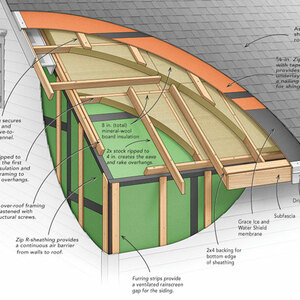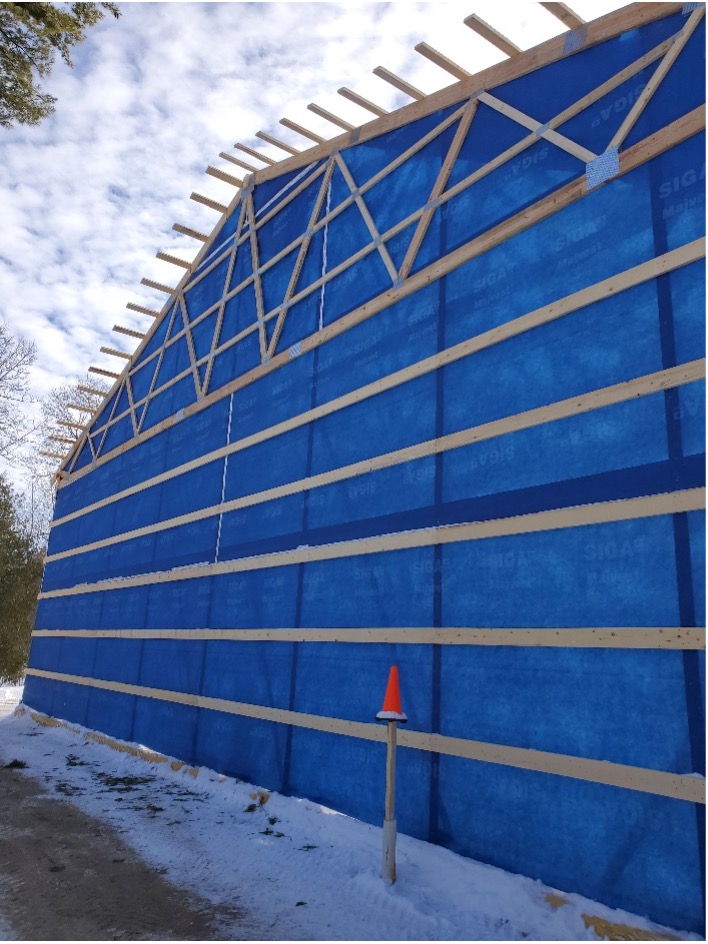
Many new homes are designed with vaulted ceilings or low-slope roofs for aesthetic reasons. It’s challenging to build an effective vented cavity in these types of roofs, so a lot of builders turn to closed-cell spray foam thinking it’s an easy solution. While this approach can work, it’s not without risks. If the new framing lumber settles or dries and shrinks, the foam can delaminate from it, providing pathways for warm interior air to reach the cold roof sheathing and condense. Over time this has the potential to cause catastrophic roof failure. Also, roof leaks tend to be harder to detect and track down if they are retained by or work their way through a layer of bonded foam. And finally, the chemicals and blowing agents used in a lot of spray foams are toxic and have high global warming potentials, not to mention significant embodied carbon in their manufacture. For these reasons, my company, Targa Homes, in Seattle, uses the alternative method detailed here.
Order of the build
This insulated over-roof, as I call it (aka “Monopoly” framing), avoids spray foam while providing a durable and high-performance assembly. The construction sequence is as follows:
Weekly Newsletter
Get building science and energy efficiency advice, plus special offers, in your inbox.

This article is only available to GBA Prime Members
Sign up for a free trial and get instant access to this article as well as GBA’s complete library of premium articles and construction details.
Start Free TrialAlready a member? Log in














17 Comments
We're planning a similar construction in climate zone 5b so we'll have a little more exterior insulation. I've seen this with and without insulation continuing onto the overhangs. How did you decide not to do that? Is it only a good idea if ice-damming is an issue?
Since the overhang is considered "outside" I'm not aware of a reason to continue the foam into that cavity, beyond the edge of the wall or any exterior insulation. Ice-damming generally results from warm air leaking into an attic. Separate issue.
I remember reading somewhere that the sun can warm up the siding below the overhang resulting in warmer air at that point so I think that was the reason for the insulation in the overhang. I'm not sure how common that is though. Sounds like maybe I shouldn't worry about it, thanks.
I am doing something similar just using peel and stick membrane as my vapor/air barrier and foil faced poly iso foam with offset seams taping the top layer. What thickness of CDX plywood did you use over the foam? I have been using 1/2”. Why did you choose EPS? What kind and size of screws are you using? What type of underlayment are you using under your roofing shingles? Do you think it matters if it breaths? Great article, thanks!
Hi!
We use 1/2" CDX ply over the foam. I chose EPS because of cost + availability. If budget allowed I would absolutely use a lower carbon biogenic product like wood fiber board. For this assembly with 2x4 overhangs we used 6" SDWS screws (which was specified by the structural engineer). Roof underlayment under shingles I believe was Safeguard but I think any typical underlayment would be fine. I can't see a reason that would need to breath. Hope this helps!
Anyone know prescriptive guidance on wind uplift worries for these attached eaves (or various ways of attaching eaves?). It's a concern that has come up as I've discussed this with builders.
Any insight into how structural engineers would model this? Any structural engineering reports that could be shared around this?
jameshowison,
The gable ends are very similar to the lookouts you use to form overhangs on trusses. With 6" Simpson SDWS screws they would have considerably more uplift resistance than is usually provided on truss ladders, where they are nailed into the dropped gable-truss. Some builders use truss-clips, which could be added in either situation.
Thanks. Yes, I have to say that it all makes sense to me, but I ain't a structural engineer and prescriptive drawings would be really useful to show people.
These are somewhat like gable ends, but the techniques shown here (for example):
https://apps.floridadisaster.org/hrg/downloads/overhangs.pdf
all rely on "in-plane" connections to the full rafters (in the case of "outlookers" using joint hangers and other hurricane clips) not application above the primary sheathing.
Could this be something where Building America could provide some guidance?
For example something like the Simpson MTS 30 wrapped over the rafter tail prior to the secondary sheathing on top? Looks like these are used for the large I-joist trusses?
https://embed.widencdn.net/pdf/plus/ssttoolbox/ovtwjkmxho/C-C-2021-p283.pdf
Anyway, my point is that discussing these details with builders every single one has been worried about this issue and that has stymied further discussions.
jameshowison,
Please consider making contact with a Building America resource group @ email: [email protected] for support.
Great. I've done that. I had sent a note to [email protected] but now I've also forwarded that to the email address you suggested.
jameshowison,
True enough. Truss overhang details appear on the supplier's drawings so you don't have to reinvent the wheel each time. Knowing the ratio of overhang to how far back they go, and the appropriate fasteners and hardware, would normalize these details.
Malcolm, that's an interesting regional difference. I have never seen roof overhang details on truss drawings; I provide details of what I want to see and they work to that, limiting eave overhangs to 24" horizontally projected.
If I don't show a rake detail they usually make the gable truss full height and if there is a rake overhang it gets applied "ladder-style." It's pretty common here in the northeast to not have any rake overhangs.
@James, GBA is not letting me post in the thread but this is in response to comment #5.
This guide is what the engineers I work with use: https://awc.org/publications/2018-wfcm/. It has tables for negative pressure (suction) on the roof surface and for determining the effect of uplift on roof rake overhangs. They don't show similar tables for applied eave overhangs, presumably because most eave overhangs are integral to the rafter, but the pressure zones at the eave are similar to the rakes so I would treat them similarly. In both cases, overhangs are limited to 2'. (And in some tables, rake overhangs are limited to 1'.)
Table R301.292) in the IRC has similar info on negative pressure on the roof cladding: https://codes.iccsafe.org/content/IRC2015/chapter-3-building-planning#IRC2015_Pt03_Ch03_SecR301.2 but not the details on overhang design.
A few comments for the author and the GBA editors:
"a lot of builders turn to closed-cell spray foam thinking it’s an easy solution. While this approach can work, it’s not without risks. If the new framing lumber settles or dries and shrinks, the foam can delaminate from it, providing pathways for warm interior air to reach the cold roof sheathing and condense. Over time this has the potential to cause catastrophic roof failure."
This is definitely a potential failure, but the hyperlink points to Matt DuPuis's article on flat roof failures that failed because they *don't* have spray foam. The failures Matt talks about in that column are people violating code and creating massive moisture failures by just filling a flat roof cavity with fiberglass. That's like talking about EV battery fires, and linking to an article on gasoline engine car fires. GBA--was that your link?
"Insulation above structural sheathing keeps the sheathing warm enough that there will not be a dew point issue (condensation) when interior air reaches it. Note that you need to use the correct ratio of exterior to cavity insulation to accomplish this. We like to hit at least 30% of the total R-value above the sheathing. For example, 3 1/2-in. of EPS foam is about R-14. A cellulose-filled 2×8 rafter cavity is about R-28. So, R-14+R-28 = R-14 = 33%."
Just to be clear: this ratio varies by climate zone, as spelled out in Allison Bailes' column, and Joe Lstiburek's article below, with the key table copied here.
BSI-100: Hybrid Assemblies
https://buildingscience.com/documents/building-science-insights-newsletters/bsi-100-hybrid-assemblies
FYI - I've used this on a few DERs and they've been through at least 3 tornados since and simply don't move. Robust for a two foot overhang. What you don't see is on the rake end, we added flat metal plates at the inboard side of the outlooks/outriggers to join up with the 2x4 furring over the 8" of foam. Then a 12" screw is driven at an angle through the outlook to the old rafters below the insulation.
One more photo to help overall look in the near end of roof build. Along the eaves you can see a 2x4 caries the weight into the 2x4 screwed to the wall. The plywood blocks under the roof furring was to get rid of a 4" sway from the 1926 2x4 rafters.
I do have to say I wrote a few nice articles about this DER two years ago but GBA turned it down saying it was way too involved. How's that for progress...
Log in or become a member to post a comment.
Sign up Log in